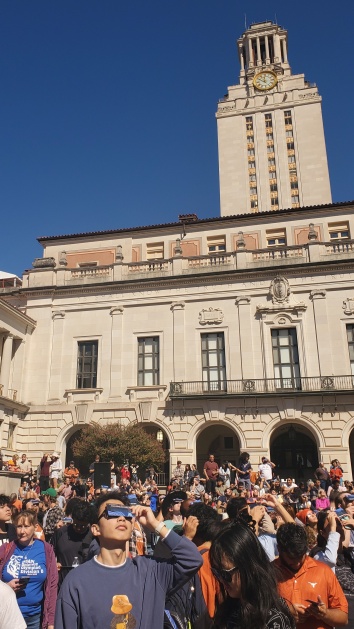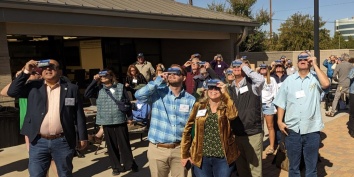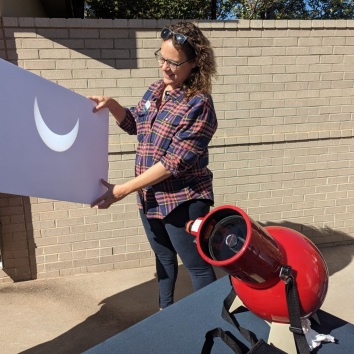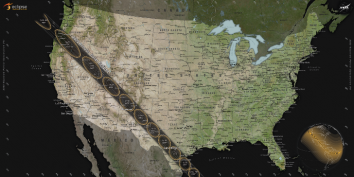
Young eclipse watchers in Alpine, Texas, added their solar viewers to paper bags for an extra layer of eye protection. Image credit: Alpine Public Library.
25 October 2023
On Saturday, October 14, Texans experienced a rare and beautiful annular “ring of fire” solar eclipse. It swept into the state from the border of New Mexico and exited by way of the Coastal Bend. Midland-Odessa, San Antonio, and Corpus Christi were all witness to the annular eclipse. The whole state was able to see a partial eclipse. (See the eclipse path here.)
What is an annular eclipse?
The Moon’s distance from Earth varies by roughly 31,000 miles (50,000 km). If an eclipse occurs when the Moon is farther away than average, the Moon isn’t quite wide enough to completely cover the Sun. That leaves a “ring of fire” around the Moon.
In April 2024, Texas will experience a second solar eclipse. However, during the next eclipse, the Moon will be close enough to cover the Sun. This will result in a total solar eclipse.
Helping the State Prepare for October’s Eclipse
In the months leading up to the October solar eclipse, McDonald Observatory was busy at work educating patrons and partners about the astronomical event. Funding from the Abell-Hanger Foundation helped to support this work, including:
In the News
With the help of state news outlets, experts from McDonald Observatory and UT Austin helped educated the public about the science of solar eclipses, how to experience them safely, and community viewing opportunities.
Highlights of annular solar eclipse coverage:
Up Next: A Total Solar Eclipse in April
In just seven months, Texas will experience a second eclipse!
On April 8, a total solar eclipse will travel from Eagle Pass, near Mexico, to the Arkansas border. Along the way, it will be visible from western San Antonio, most of Austin, and all of Waco, Dallas, and Fort Worth (see the path here).
During a total solar eclipse, people within the “path of totality” will see the Moon completely cover the Sun’s disk. When the Sun is covered – a moment called “totality” – people in the path will be able to see the Sun’s feathery corona radiating outward.
Many consider total solar eclipses to be more dramatic than annular solar eclipses. To start planning your April 8 viewing, visit our eclipse guide at www.mcdonaldobservatory.org/eclipse.

Young eclipse watchers in Alpine, Texas, added their solar viewers to paper bags for an extra layer of eye protection. Image credit: Alpine Public Library.

An estimated five thousand or more people experienced the partial solar eclipse from The University of Texas at Austin. Image credit: McDonald Observatory.

Eclipse watchers experiencing the annular “ring of fire” solar eclipse at the Abell-Hanger Foundation in Midland, Texas. Image credit: McDonald Observatory.

McDonald Observatory Assistant Director for Education and Outreach Katie Kizziar using an Astroscan telescope to project an image of the solar eclipse in Midland, Texas. Image credit: McDonald Observatory.

Path of the October 2023 annular solar eclipse. Image credit: NASA.